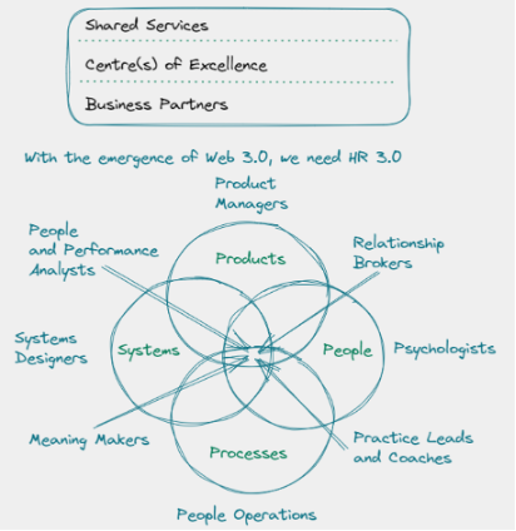Read part one here.
Introduced in the mid-1990s, this model is known as the Ulrich Model. It was a time of lean, sigma, business process reengineering - the dawn of networked technologies and e-commerce. Now we are in a period of virtual and augmented reality, generative artificial intelligence, machine learning, blockchain, agile, organisational resilience and much more.
A model that’s approaching three decades on from its inception surely needs a reboot or an upgrade? To be fair to Ulrich, he has been adding to his thinking and sharing lots of value-creation and adapted insights.
But a new model does not exist. That’s why I think it’s time - and I’m determined to use my final months as the top ranked HR Most Influential Thinker - to showcase what I believe a new model could be.

HR 3.0 model
People, processes, systems - all really obvious. Products? That’s a new aspect we’ll cover in a future article, but this model must already beg lots of questions. The first one: where are the HR business partners (HRBPs)?
The answer is (not glibly) everywhere. They are certainly:
- Relationship brokers. A key element of HR business partnering is establishing a connection with business leaders and their teams. And also within HR itself. Which is why this is at the epicentre of this model.
- People and performance analysts. It may be time (and we’ve already seen this in some larger HR/people and culture teams) to hone in on data and analytics much more actively and with increased impact for the enterprise and HR itself.
In larger teams, there will be roles (perhaps not even called HRBPs) dedicated to performance, capabilities, inclusivity, creativity, alignment to strategic goals and the reporting on the dreaded but perhaps necessary phrase human capital. - Practice leads and coaches. Many HRBPs spend time coaching leaders, managers, and teams - be it around strategic workforce planning, performance management, ER, talent development and their inter-relationships with other functions and people. There is no reason why this should not continue as a value-add to HRBPs’ delivery proposition.
- Systems designers. Attuned to the needs of their business domains, there is an active role for HRBPs to be part of the instruments of change and refinement as part of organisational development (OD).
In some cases, HRBPs are skilled in OD and in others less so. It is not critical that HRBPs become OD practitioners on top of their existing role. However, they link strongly to OD professionals as they are privy to the changing demands of business leaders and play a vital part in the value chain. This avoids convulsive and ineffective restructuring in favour of a more fluid, evidential and science-based OD and development frame of operating. - People operations. Linking administration, utilisation of technology, gathering data, service and demand management. These are all important and enhanced by good HRBP intelligence, application and promotion of efficient administrative practices across their business domains.
- Meaning makers. Purpose, inclusion, belonging, psychological safety, going beyond engagement, flexible ways of working, values and value creation, motivation, problem-solving and future-casting. We are seeing more and more that this isn’t simple white-collar privilege. It’s essential people see how what they do matters, they are valued and they are aligned with people and the organisation in their intention and commitment to their work.
In my work with HRBPs over the past 20 years, I’ve seen all of these components stacked into the role. What this model does is recognise that the HRBP role crosses all boundaries of the HR domain and therefore why constrain it to one pillar of a three-pronged model? It’s transient, adaptive and responsive.
So there’s no fixed home for HRBPs and there are many guises for them to be a part of. HRBPs are the link, the intelligence source, the agitator, the analyser, and the equaliser.
In this model, we see a more unleashed HRBP. Whether that title remains is up to individual teams to decide. HR business partners V1 and V2 are dead. Long live the 3.0 HR business partner.
Perry Timms is founder of PTHR and ranked first on the HR Most Influential Thinkers list in 2022.







